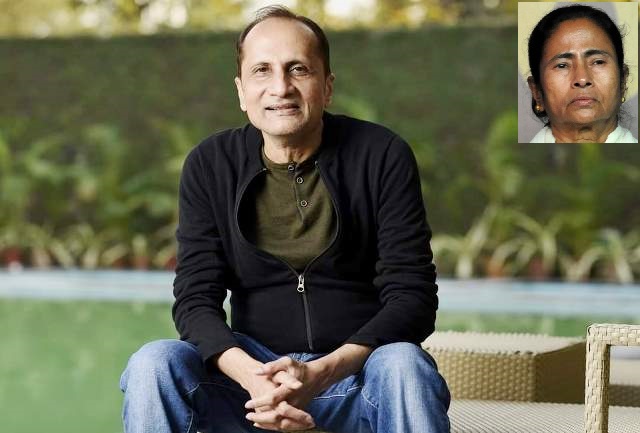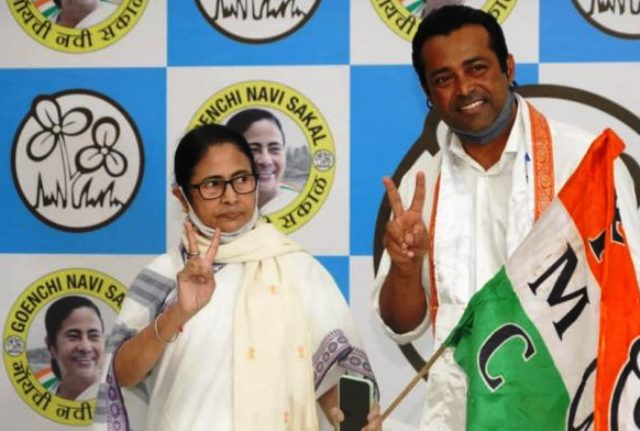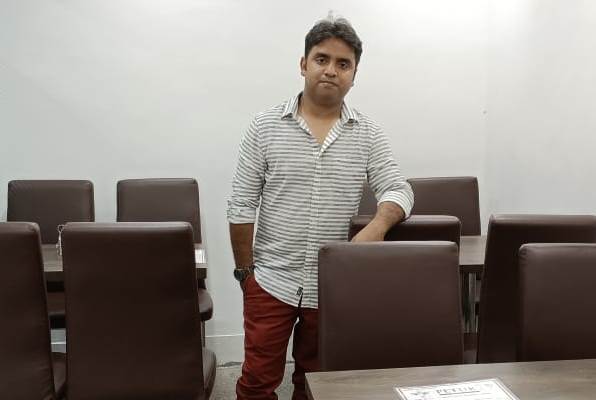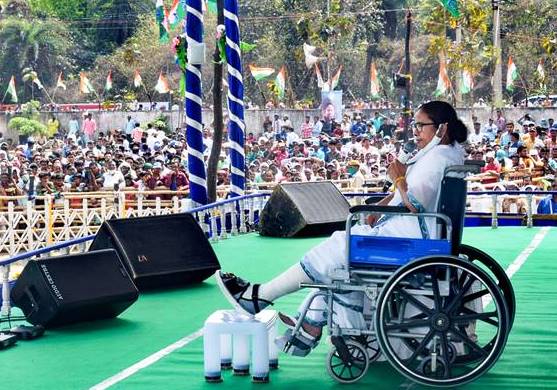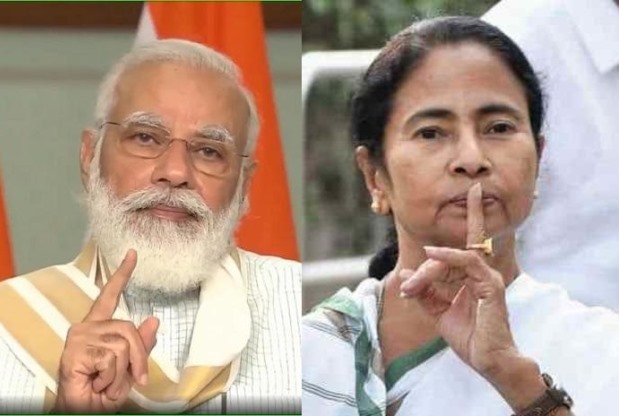Her opponents brand her as a ‘drama queen’ and she has been trolled by BJP supporters after she suffered multiple injuries outside a temple at Nandigram on March 10. This followed a highly successful rally where she invoked the secular shared spaces of a syncretic society, even while chanting shlokas and mantras which are familiar and embedded in the Bengali consciousness. Her medical reports show she has suffered injuries and a fracture on her left ankle. Her leg is in a cast, even as she continues to campaign from a wheelchair.
In such circumstances, if a chief minister of a state suffers injuries in an accident, or attack, the least that should happen, even in the bitterness and heat of the elections, is that good wishes would be sent to her-him for a speedy recovery. This is the basic protocol of public decency and democratic fair play. For reasons too crudely apparent in contemporary India, that dimension seems to have altogether disappeared from the political arena of opponents, especially in the current battleground that is West Bengal.
Not heeding the doctor’s advice, as she said, of rest for 14 days, she joined in the memorial service of party supporters in Kolkata to the 14 martyrs of Nandigram in 2007. She was paying tribute to a mass movement against forcible land acquisition for a multinational company, which toppled the ruling Left Front government, led by the CPM, after 34 years. She then led a long march in Kolkata sitting on a wheel chair.
Since the Nandigram fiasco, the Left has depleted in strength, confidence and inspiration, while under the indisputable and formidable leadership of Mamata Banerjee, Trinamool Congress has consolidated its hold on power and mass support, despite allegations of corruption and promotion of dynasty.
Besides, her government has done extensive social welfare work among the people, especially among the poor, including the minorities. For instance, rice, dal, oil, etc, is still being given in substantial quantity to poor people across the state even months after the lockdown was lifted. This has helped thousands of people survive without jobs or daily wages, and restart their lives once again.
The 43 per cent vote bank of Trinamool has remained intact even while the BJP scored almost 40 per cent vote share and 18 Lok Sabha seats in Bengal, from being nothing but a marginal figure in the state’s political scenario. Since then, it has been a straight contest between Mamata and all the heavyweights of the BJP combined, led by Narendra Modi, Amit Shah and JP Nadda, who have become regular visitors to Bengal, accompanied by all the paraphernalia, pomp and show, and media glare.
And, yet, in these assembly elections, despite pumping in money and media support, a lot of rhetoric and grand promises like ₹15,000 in every farmer’s bank account, backed by convoys of cars and rath yatras with slogans of Jai Shri Ram, the BJP is still not able to find its scaffoldings, or the right strategy. Seasoned political commentators are certain that there is no BJP wave on the ground. After the flop rally at the Brigade Ground led by Modi on March 7, with vast spaces empty and an unenthusiastic crowd, and practically no celebrity joining them except an ageing Mithun Chakraborty, observers say they will struggle to even cross the 100 mark in a 294-seat assembly.
In contrast, Mamata seems to have touched the right chord. “I am hurt and unwell, but my goal remains the same. My pain is not greater than the suffering of the people whose rights in a democracy are being trampled upon by a dictatorship,” she said, sitting on the wheel chair, before the start of the march in memory of the Nandigram struggle on March 10. “I will continue to go around Bengal on this wheelchair. If I go on bed rest, who will reach out to the people of Bengal? …A wounded tigress is more dangerous.”
Street shows and rallies usually do not translate into votes. The Left-Congress alliance organised a massive rally at Brigade Ground in Kolkata with the crowd spilling over on February 28. In 2019 also, the Left had organised a massive rally at the venue. But, the Left scored zero.
It is believed in Bengal that large number of Left supporters, who obsessively hate the Trinamool, voted for the BJP in the last Lok Sabha elections. The Left-Congress alliance in the last assembly elections had trouble on the ground with the CPM getting less seats than the Congress because it was alleged that the Congress votes were not transferred to the Left.
However, processions and rallies have also been a catalytic indicator of mass support, and Trinamool has been able to translate it on the ground with its organisational strength, much of it refurbished on the erstwhile Left model. Hence, the failure of the BJP’s ‘Poribortan Rath Yatra’ across the five points of Bengal is significant. Besides, Jai Shri Ram did not resonate with the people who are worshippers of Durga, Kali and Krishna (Hari), and followers of the Bhakti-Vaishnav tradition of Chaitanya Mahaprabhu, as much as the secular spiritual inheritance of Ramakrishna Paramhans and Vivekananda. Clearly, the Hindutva card of the Hindi heartland might not click in Bengal.
On March 15, Amit Shah had to cancel his rally at Jhargram in the crucial Jangalmahal area. The BJP said there was a helicopter snag. The ground reality is that the rally ground was virtually empty. The seven-minute virtual speech made by Shah saw the crowds walking off, in a state where Hindi remains an alien language. Shah’s short speech was too short, an indication that the BJP is losing the plot in Jangalmahal. Jhargram had earlier witnessed a similar flop-show with JP Nadda reportedly refusing to even visit the venue because of low audience strength. Earlier, Nadda’s rath yatra was jinxed in Barackpore too. Even Yogi Adityanath’s much-hyped rally at Balrampur in Purulia on March 16 saw a very poor turn out.
In fact, the low turn-out at BJP rallies have become a big worry in the party, as much as the internal tussle for tickets. Amit Shah had to rush from Guwahati to Kolkata to sort out matters even as BJP workers broke barricades at the Hastings party office in Kolkata. While a few Trinamool MLAs have crossed over to the BJP, there is resentment in the party against tickets being given to turn-coats or ‘outsiders’.
The question is: if the BJP has mass support, why is it not showing up in public spaces? Or, is it banking on its silent support base, as in the unprecedented Lok Sabha elections in 2019, especially among the economically deprived Hindu refugees who arrived from Bangladesh in the 1980s, migrants from UP and Bihar, and sections of the middle class? Is it still banking on the botched-up and sectarian Citizenship Act plank to woo the Hindu refugees and other backward and indigenous communities like the Matuas and Rajbongshis?
While, the BJP is still struggling to find a strategy, Mamata Banerjee, on a wheel chair, is moving from one rally to another of the 130 scheduled. As the battle unfolds, even a neutral referee would say, it is Advantage Mamata, as of now! In fact, nothing describes the current political situation in the state better than the Trinamool’s catchphrase which says: Khela Hobe! Bhaanga Payein Khela Hobe!! (The game is on! With a fractured foot, the game is on!!)

